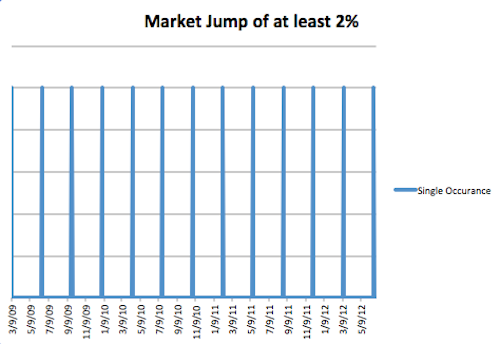The No. 1 Reason to Be a Buy-to-Hold Investor
Back in the early 1900s, Italian economist Vilfredo Pareto noticed that about 20% of the peapods in his garden offered up 80% of the peas. Fascinated by this, he wanted to see if the same rules applied to human endeavors.
When he did the research, he found in fact that 80% of the land in Italy was owned by 20% of the population. Though the actual ratios vary, the basic principal remains the same: A disproportionately small number of subjects usually account for a disproportionately large amount of results.
So why does this matter to long-term, buy-to-hold investors?
If we take Pareto's principal one step further, we can say that 20% of trading days should account for 80% of the market's returns. If you're a trader, navigating in and out of stocks on a daily basis, there's a good chance you might miss some of the big days that make up huge gains for the market. And because the market historically goes up -- not down -- there are usually more up days to miss than down days.
If those big days were evenly spread out, we would expect days where the market jumped by more than 2% to be spread out like this, where each line represents an occurrence of a 2% (or more) market jump.

Buy-to-hold investors would already hold an advantage over day traders if this were the case, as they would never miss out on one of these outsized gains.
But as author and professor Albert-Laszlo Barabasi points out, such occurrences are rarely random and evenly distributed. Instead, they occur in bursts. Take a look at how the distribution of such big market gains (the S&P 500 (INDEX: ^GSPC) ) have been spread out since March 9, 2009 -- the market bottom of the Great Recession.

Source: Fool.com, author notes.
As you can see, such big leaps usually occur in bursts. If you aren't invested in these bursts, then you've missed out on the wealth-making machine that is the stock market. As fellow Fool Morgan Housel likes to say, "History doesn't crawl; it leaps."
To really drive home the point, consider this: The S&P 500 has returned 93.7% since the market hit rock bottom during the Great Recession -- not including dividends. If you had missed the five days with the biggest gains since then, your returns would only be 51.7%. In other words, a mere 0.6% of trading days accounted for 45% of gains.
Of course, skeptics will look to the data and point out that, obviously, with the market hitting rock bottom, euro jitters dissipating, and the debt-ceiling can being kicked down the road, any idiot could have guessed there would be huge market gains.
Of course, they'd be right -- if we knew those things were coming. Few people could foresee the large market days before they came. In reality, there's no way to tell when and where the next burst may occur. If someone tells you it's coming, ask them to be specific, then see if they're right.
That's why market timing just doesn't work, and investing as if you own the businesses you're buying does.
This isn't just a macro-issue
Just in case you read this thinking, "Who cares. I invest in individual companies, not the total market," consider the following five companies. I own all five of them, and they have performed very well in 2012.
If you take out the single day with the biggest gain, look at how the returns change. Click on the days with the biggest gains to find out what caused such gains.
Company | 2012 Returns | Biggest Single Gain | Returns Without the Biggest Day |
|---|---|---|---|
Apple | 41% | 28% | |
Whole Foods (NAS: WFM) | 40% | 30% | |
Stratasys (NAS: SSYS) | 48% | 32% | |
Solazyme (NAS: SZYM) | 11% | 1% | |
IPG Photonics (NAS: IPGP) | 25% | 1% |
Source: Fool.com, all returns as of market open, June 27, 2012, returns include dividends.
In some cases, these jumps were the result of earnings releases, but that wasn't true for IPG, Solazyme, or Stratasys.
We're all about buying stocks with the intent of holding them for the long term here at the Fool. If you'd like to find out what three stocks will be leading the new industrial revolution, I suggest you check out today's special free report. Inside you'll get the name and tickers of three companies leading the 3-D printing revolution. Get your copy of the report today, absolutely free!
The article The No. 1 Reason to Be a Buy-to-Hold Investor originally appeared on Fool.com.
Fool contributor Brian Stoffel owns shares of all the companies mentioned in this piece. You can follow him on Twitter, where he goes by TMFStoffel.The Motley Fool owns shares of Solazyme, IPG Photonics, Apple, and Whole Foods Market. Motley Fool newsletter services have recommended buying shares of Whole Foods Market, Stratasys, IPG Photonics, and Apple, and creating a bull call spread position in Apple. The Motley Fool has a disclosure policy. We Fools may not all hold the same opinions, but we all believe that considering a diverse range of insights makes us better investors. Try any of our Foolish newsletter services free for 30 days.
Copyright © 1995 - 2012 The Motley Fool, LLC. All rights reserved. The Motley Fool has a disclosure policy.

